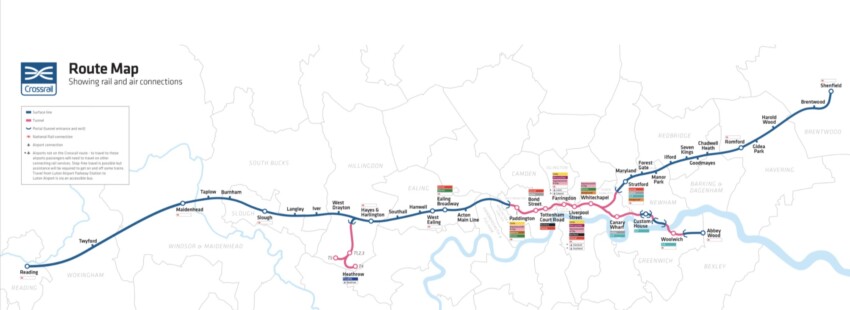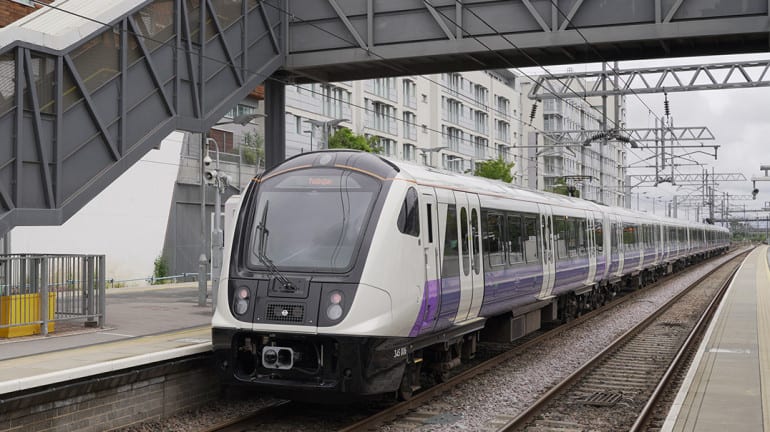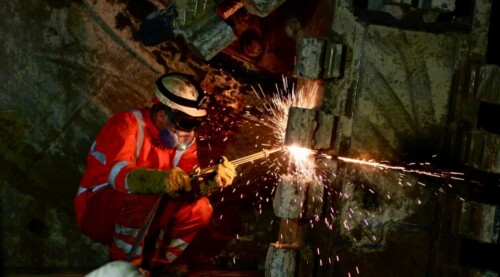
Under the Existing Subway Systems in Paris and London, Two Huge New Sections of Tracks are Being Built
By Aysia Reed
In two of Europe’s most important cities, the ground below the existing subway lines is being excavated to create more than 200 additional miles of subterranean track in Paris, and up to 100 more miles below London.

The below-surface railway systems are making shorter journey times, an economic boost, and more efficient connections.
It’s all happening right now, these megaprojects that will transform both cities. In Paris, the new tracks will go far below the existing subway, creating a whole new level of underground transportation.
The Paris Metro and Crossrail project’s goal is to reinvent and improve travelers’ transits to and from the major cities.
Paris Metro
Paris, unlike many major cities, doesn’t have a ring road going around it, so to traverse the city you often have to go right through it. For long travels, the Paris Metro is a convenient form of transportation, but they needed a way to connect disparate parts of the city such as airports and rail stations.
This is how the massive project is described by Paris officials.
“Four new métro lines will be developed: lines 15, 16, 17, and 18, while other lines are to be extended (lines 14 and 11). Upon completion, this new metro network will serve 72 stations (including 57 new stations), which will be strongly interlinked with the existing transport network, and will link the three airports and the high-speed railway (TGV) stations.
Thanks to the new network’s many connections with métro lines, RER, train lines and tramways, mobility in the region will be enhanced and will ensure better connections between residential and employment areas, without requiring changes in the center of Paris. Upon completion, two million passengers will use the network on a daily basis. Residents, as well as businesses, will benefit from this new, more effective, and linked-up network.”
The Current Paris Metro
The Paris Metro is currently 133 miles long and transports over 1 billion passengers a year. It is the second most used metro system in all of Europe. The Paris Metro has 16 lines and 303 stations within France.
The Paris metro opened in the early 1900s, making it one of the oldest metro systems in the entire world.

Train Components and Etiquette
Each train is customized and has different shapes, colors, and sizes from one another. The trains do not have a conductor; they are all fully automated. The doors are mostly automatic and gates on the platforms are in sync with the automatic doors for safety precautions.
If the door is not automated, a button or lever will be on the outside of the train’s door. It is the etiquette for the travelers waiting for the train to press this button/lever and allow the passengers already on the train to exit.
Tickets and Maps
Ticket prices begin at €1,90, but prices can be discounted if 10 tickets are purchased at once. Starting this year, however, printed tickets will be phased out and e-tickets will be used instead.
It is also important to keep in mind that tickets to the suburbs are more expensive than the standard metro price. Ticket machines will display your options, along with translations.

Navigo Easy cards are also a new feature and can be used in place of paper tickets if you do not wish to use your cellphone. With a purchase of the card, you are given unlimited rides of the Paris Metro for the entire week.
The card costs only 2€, and each traveler must have their own; a card cannot be shared. The incentive behind the card is to reduce waste with paper tickets and make an easier and more efficient travel.
RATP, the public transportation network of Paris, has a website that displays maps, routes for the subways, timetables, and valuable information regarding Paris.
The website is easy to access and asks you to put in your current location, and where you are traveling to.
The Paris Metro map is also helpful when planning routes. The map includes an easy depiction of the lines, stations, and interchanges for passengers. Having the map on your phone makes it less of a hassle when trying to navigate your route.

The London Crossrail and New Elizabeth Line
Although it is not yet open, Crossrail will offer exciting new features that the transportation field has never seen before. The new Elizabeth line will be the very first underground rail in over 30 years.

The Crossrail project is the largest undertaking that the UK has ever seen.
The Crossrail in London is extending the Elizabeth Line over 100 kilometers below the heart of the city.
The project has been in the works since 2004, when the route was first planned out.
The incentive behind the railroad was to cut down travel time due to London’s growing population and provide an economic spur.
Railway users will also no longer have to transfer onto any other mode during their travels, the new lines will mesh with the existing Docklands light rail and the traditional underground of London.
Forty-one new and upgraded stations and 42 kilometers of new tunnels are an addition to the underground Crossrail. The project has cost a whopping £18 billion but is adding £42 billion to the UK economy.
Over 1 million people would now be able to travel across London underground in just around 40 minutes, and over 200 million people are estimated to use the rails annually.
It is predicted to be completed by early 2022, but some testing on the railway is required before it is officially completed.
The Toll on the City
Although there are many positives to the line opening, Crossrail being the largest infrastructure enterprise within the Western hemisphere has caused an uprising for residents of London.
The project has changed how other frameworks have been built and natives have described the city as unrecognizable since the project has begun. The well-known Astoria Theatre was demolished in order to make room for one of the newly built stations. Residents hope that the sacrifices and costs of the Crossrail will offset the negatives.
London’s mayor, Sadiq Khan released documents in December of 2018 stating how the Crossrail went £3 billion over their budget, and that the project was being managed poorly.
However, The UK’s National Audit Office released a statement saying that they had been given an unrealistic timeline of the entire project, and this has caused a major delay for them.

Unfinished Business
Dynamic testing of the trains is something that those working on the project have yet to complete.
This testing is essential to the opening of the Crossrail. Dynamic testing will ensure that the trains do not have any electrical issues while in transit.
The trains will also be run closely together to test the dynamic while multiple rails are in use.
Covid-19 has also caused delays with the project. A reduced amount of contractors are allowed on the premises, and the rest of the workers are doing their jobs remotely. Their focus at the moment is still on dynamic testing.
The rollouts of both Crossrail in London and the Grand Paris Express will be in stages starting in 2022. But one thing is guaranteed, you’ll be seeing a whole lot more of both city’s undergrounds in the years to come.
Eurail Passes: What to Know about Buying a Europe Train Pass
- All Aboard the Amazing Texas High-Speed Train - June 11, 2021
- Amazing Undersea Sculptures: Museum of Underwater Art - June 3, 2021
- B.C.’s Stunning Golden Skybridge and Icefield Skywalk - May 28, 2021





